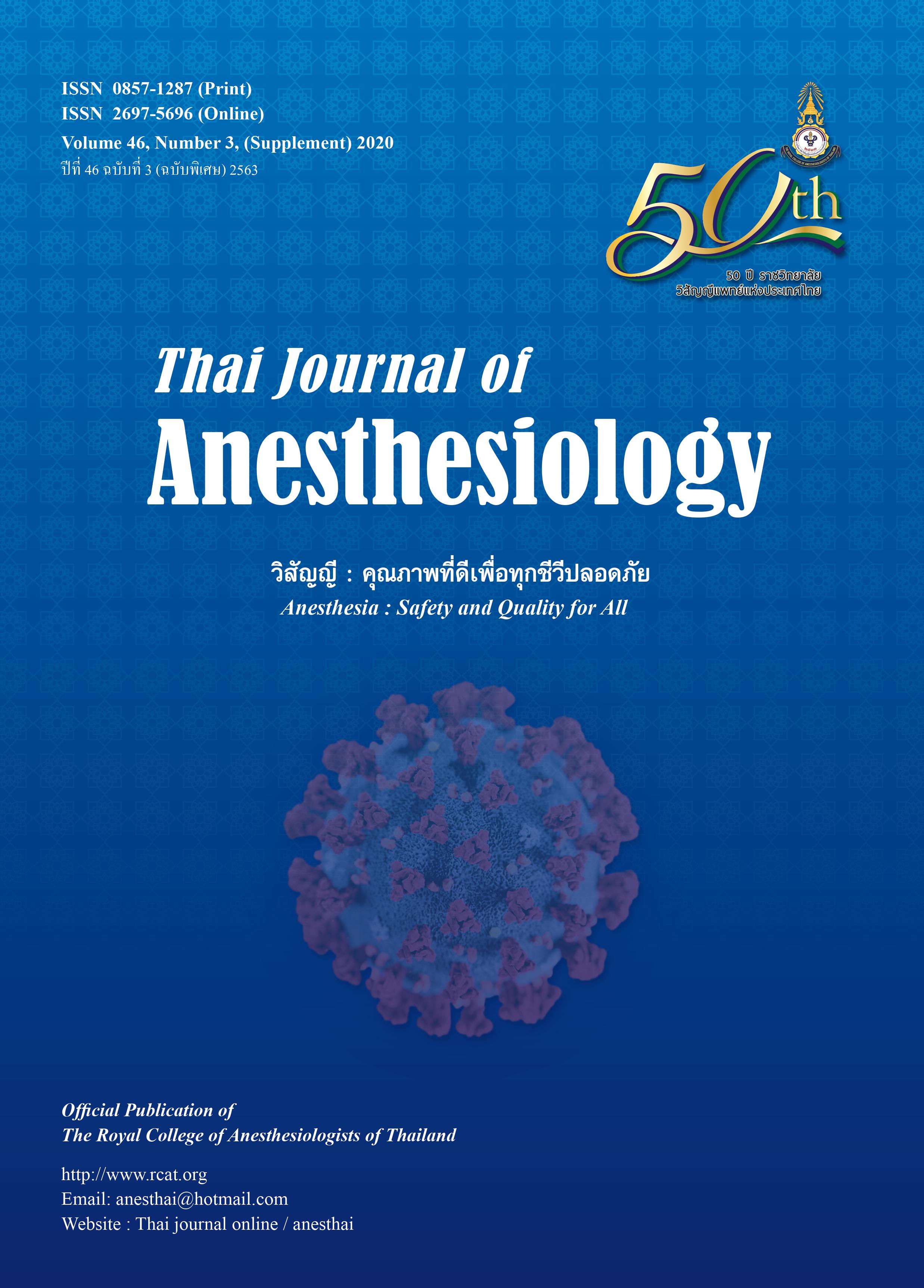Anesthesia for Emergency Open Reduction and Internal Fixation of the Unstable Cervical Spine Fracture during COVID-19 Pandemic
Main Article Content
Abstract
Anesthetic management of a patient with an unstable
cervical spine fracture, presented with neurological
deficit, who has also been classified as a Patient Under
Investigation (PUI) for COVID-19 should be strictly
adhered to standard recommendations and guidelines in
the same manner of confirmed COVID-19 cases. In
addition to the use of appropriate personal protective
equipment (PPE) for anesthesia providers with direct
patient contact, tracheal intubation performed by
experienced personnel are highly suggested. In this case
report, awake tracheal intubation using video laryngoscope
with separate video monitor screen was successfully
performed. Viscous lidocaine gargles along with
intravenous lidocaine were previously administered in
order to reduce coughing during intubation. Proper
endotracheal tube position and placement were assessed
and confirmed by using vocal cord marker and
end-tidal capnography, respectively. Above all, providers
should always be aware of viral spreading caused by
contamination of patient’s secretion which can be
minimized by limiting the number of anesthetic equipment
and anesthesia personnel with clear role and responsibility,
providing appropriate zoning management plan. After the
operation, respiratory secretions should be collected for
detection of SARS-CoV-2 and appropriate equipment is
required during patient transport.
Article Details
References
different types of clinical specimens. JAMA 2020; 323:1843-44.
2. กรมการแพทย์. คำแนะนำการใช้อุปกรณ์ป้องกันตนเองกรณี โค
วิด-19 [Internet]. 20 เมษายน 2563 [สืบค้น 28 พฤษภาคม 2563]
สืบค้นจาก: http://covid19.dms.go.th/Content/Select_Landding_
page?contentId=68
3. กรมการแพทย์. แนวปฏิบัติการทำหัตถการและการผ่าตัดใน
สถานการณ์การระบาดของ COVID-19 [Internet]. 7 พฤษภาคม
2563 [สืบค้นเมื่อ 28 พฤษภาคม 2563]. สืบค้นจาก: http://
covid19.dms.go.th/Content/Select_Landding_page?
contentId=70
4. Zucco L, Levy N, Ketchandji D, Aziz M, Ramachandran S.
Perioperative considerations for the 2019 Novel Coronavirus
(COVID-19) [Internet]. 2020 [cited 2020 May 18] Available
from: http://www.apsf.org/news-updates/perioperativeconsiderations-
for-the-2019-novel-coronavirus-covid-19.
5. American Society of Anesthesiologists. The Use of personal
protective equipment by anesthesia professionals during the
COVID-19 pandemic. [Internet]. 2020 [cited 9 April 2020]
Available from: https://www.asahq.org/about-asa/newsroom/
news-releases/2020/03/update-the-use-ofpersonalprotective-
equipment-by-anesthesia-professionals-duringthe-
covid-19-Pandemic.
6. Orser BA. Recommendations for endotracheal intubation of
COVID-19 patients. Anesth Analg 2020;130:1109-10.
7. Zuo MZ, Huang YG, Ma WH, et al. Expert recommendations
for tracheal intubation in critically ill patients with Noval
Coronavirus disease 2019. Chin Med Sci J 2020; Feb 27.doi:
10.24920/003724.
8. Malcharek MJ, Rogos B, Watzlawek S, et al. Awake fiberoptic
intubation and self-positioning in patients at risk of secondary
cervical injury: a pilot study. J Neurosurg Anesthesiol
2012;24:217-21.
9. Rosenblatt WH, Wagner PJ, Ovassapian A, Kain ZN. Practice
patterns in managing the difficult airway by anesthesiologists
in the United States. Anesth Analg 1998;87:153-7.
10. Wong DM, Prabhu A, Chakraborty S, Tan G, Massicotte EM,
Cooper R. Cervical spine motion during flexible bronchoscopy
compared with the Lo-Pro GlideScope. Br J Anaesth
2009;102:424-30.
11. Flexman AM, Abcejo A, Avitisian R, et al. Neuroanesthesia
practice during the COVID-19 pandemic: recommendations
from Society for Neuroscience in Anesthesiology & Critical
Care (SNACC). J Neurosurg Anesthesiol 2020. doi: 10.1097/
ANA.0000000000000691
12. Turkstra TP, Craen RA, Pelz DM, Gelb AW. Cervical spine
motion: a fluoroscopic comparison during intubation with
lighted stylet, GlideScope, and macintosh laryngoscope.
Anesth Analg 2005;101:910-5.
13. Lennarson PJ, Smith D, Todd MM, et al. Segmental cervical
spine motion during orotracheal intubation of the intact and
injured spine with and without external stabilization.
J Neurosurg 2000;92:201-6.
14. Hastings RH, Kelley SD. Neurologic deterioration associated
with airway management in a cervical spine-injured patient.
Anesthesiology 1993;78:580-3.
15. Muckart DJ, Bhagwanjee S, Van der merwe R. Spinal cord
injury as a result of endotracheal intubation in patients with
undiagnosed cervical spine fractures. Anesthesiology
1997;87: 418-20.
16. Gerling MC, Davis DP, Hamilton RS, et al. Effects of cervical
spine immobilization technique and laryngoscope blade
selection on an unstable cervical spine in a cadaver model
of intubation. Ann Emerg Med 2000;36:293-300.
17. Holmes MG, Dagal A, Feinstein BA, Joffe AM. Airway
management practice in adults with an unstable cervical
spine: the Harborview Medical Center experience. Anesth
Analg 2018;127:450-4.
18. Serocki G, Neumann T, Scharf E, Dörges V, Cavus E. Indirect
videolaryngoscopy with C-MAC D-Blade and GlideScope:
A randomised, controlled comparison inpatients with
suspected difficult airways. Minerva Anestesiol 2013;79:121-9.
19. Lennarson PJ, Smith DW, Sawin PD, et al. Cervical spinal
motion during intubation: efficacy of stabilization maneuvers
in the setting of complete segmental instability. J Neurosurg
2001;94:265-70.
20. American College of Surgeons. Advanced trauma life
support: student course manual. 10th edition [Internet]. 2017
[cited 18 May 2020]. Available from: https://viaaerearcp.files.
wordpress.com/2018/02/atls-2018.pdf
21. Malik MA, Maharaj CH, Harte BH, Laffey JG. Comparison of
Macintosh, Truview EVO2, Glidescope, and Airwayscope
laryngoscope use in patients with cervical spine immobilisation.
Br J Anaesth 2008;101:723-30.
22. Austin N, Krishnamoorthy V, Dagal A. Airway management
in cervical spine injury. Int J Crit Illn Inj Sci 2014;4:50-6.
23. Nolan JP, Wilson ME. Orotracheal intubation in patients with
potential cervical spine injuries; an indication for the gum
elastic bougie. Anaesthesia 1993;48:630-3.
24. Thiboutot F, Nicole PC, Trépanier CA, Turgeon AF, Lessard
MR. Effect of manual in-line stabilization of the cervical spine
in adults on the rate of difficult orotracheal intubation by direct
laryngoscopy: a randomized controlled trial. Can J Anaesth
2009;56:412-8.
25. Kumar D, Gombar S, Ahuja V, Malhotra A, Gupta S. GlideScope
versus D-blade for tracheal intubation in cervical spine
patients: A randomised controlled trial. Indian J Anaesth
2019;63:544-50.
26. Wuermser LA, Ho CH, Chiodo AE, Priebe MM, Kirshblum
SC, Scelza WM. Spinal cord injury medicine. 2. Acute care
management of traumatic and nontraumatic injury. Arch Phys
Med Rehabil 2007;88:55-61.
27. Hadley MN, Walters BC, Grabb PA, et al. Blood pressure
management after acute spinal cord injury. Neurosurgery
2002;50(3 Suppl):S58-S62.
28. Miller SM. Methylprednisolone in acute spinal cord injury: A
tarnished standard. J Neurosurg Anesthesiol 2008;20:140-2.
29. Yee TJ, Swong K, Park P. Complications of anterior cervical
spine surgery: a systematic review of the literature. J Spine
Surg 2020;6:302-22.


